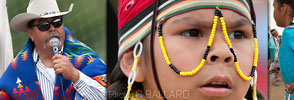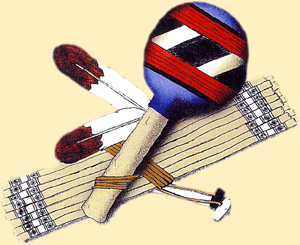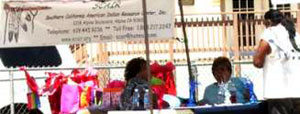 |
 |
 |
| ABOUT CALIE MISSION STATEMENT Publishing Corner: Indian Community: Science & Wonder Indian Heros: California Indian Art: CALIE Library: Academic Financial Aid: Tribal Governments: Indian Gaming: |

SYCUAN 2ND TRADITIONAL GATHERING 2008Story and photos by Roy Cook, Opata-Oodham, Mazopiye Wishasha: Writer, Singer, Speaker Sycuan Tribal land is the Southern California location of this two-day gathering, June 28-29, 2008, of fine friends and relatives for this traditional Yuman singing and dance. The Sycuan people hosted visitors and friends to their second annual Traditional gathering. Louis Guassic and Charlene Worrel-Eckel organized this event. There is an excellent breakfast and a hosted catered lunch of: salad, bread, buns fixings for the hamburgers and hotdogs, corn on the cob, baked chicken, barbeque ribs and soda pop or bottled water. Danny Tucker, Sycuan Tribal Chairman, is attentive and happy to see so many visitors attending. This weekend is a blessing from the Creator. All we can desire, need and enjoy is evident in the company of the most beautiful people in the world: Tribal People.
Saturday afternoon and it is a bit warm and sunny in the arena. However, today is a day to enjoy the richness of the local cultures custom and tradition. Tomorrow is another day and it will mostly see the finals to some of the serious competition from Saturday. Yes, it is wonderful to experience this energy and vitality in the presence of this continuity of culture. All around the arena we see: Children smiling in play, Grandparents being protective and instructive to all children. Also, most evident, the women are always the strength and first in tribal country.
This year there is a fair like atmosphere to the booths and attractions. Games galore: spin the wheel, pop the balloon, sand craft of rainbow colors, throw this, catch that, bounce here, dunk the guy in the tank or find out who can help or provide information on education, health and Indian programs like TANF or SCAIR and many other organizations. But beyond this are many entertaining events throughout the afternoon for all age groups. A competition of beautiful babies for all to ooh and ah. Also there is Good ole Rock and Roll from the East county Arrowhead Band. Tug of war between Bands and age groups, watermelon eating contest, gunny sack races, and egg in a spoon races, serious horseshoe competition provided many Kodak moments. Wonderful butterflies of color come to mind as we see the dancers in the arena, bouncing and dipping in response to the songs. The songs for the competition are lead by Leroy Elliot, Chairman of the Manzanita Band and Wally Antone, Quechan and their support singers. YUMAN SONG STYLES & CULTURAL PROTOCOL: These songs are the Yuman song styles of Tucuk “Bird song”. Most will agree many of the songs have a distinct identity with the Colorado River or Mohave presentation series. Yet at the same time each style is identifiable to the region singing the song: Northern or River or Tipai Kumeyaay.
Yuman song style is very often is generally labeled Bird songs. There are from 12 to 14 variations of the Yuman song style: Tukuk, Lightning, Salt, Lasha, Wildcat and various Northern tribes variations of songs. Yuman or Bird Song singers are a vital element in the Kumeyaay custom and tradition in the Southern California Native American social structure. Bird Singers occupy responsible roles. Traditionally, early in life, potential singers are introduced to established lead singers. During these associations young singers are evaluated to determine: commitment, capacity to learn, and qualities essential to group singing as opposed to individual performance. Essentially, the Yuman or Bird songs in their traditional role are a series of epic song cycles in the oral tradition. These songs also fulfill a social role as entertainment and many times are sung just for the joy of the occasion. Further, these Bird songs may also be sung as a Kumeyaay Traditional Community presentation. At these occasions protocol is formally defined. There are regional variations in Yuman song but essentially the lead singer and helpers or singers begin by standing or they are seated in a row. After a series of songs, variable to the occasion, the lead singer will rise and dance forward in a series of small steps. Then they will dance backward until they contact the seats or close proximity to the starting point. Also, a facing row of dancers will often assemble, mostly female, and guided by the gourd rattle and song complete the balance and the presentation. The dancing is often inspiring to the moment and lead singers’ song selectionSo often I have over heard comments on Bird Singing from outside observers to the culture, “They all sound alike." also "They just go back and forth, over and over." Yet to the informed observer, these songs are a complex sophistication of multiple related songs. The singer may or may not elect to bring out double step, or triple step songs, spins or turns. There is beautiful regalia and ribbons in complex designs. Tribal tradition is visible in each smile and proud glance, everywhere in glorious splendor. There are many friends and familiar faces, all of us a little older but still enjoying our Indian ways. Peon songs are sung in the evening into the early hours of the morning. Often the youth will form into teams and start games early in the evening and later the adult teams organize and they will warm up well after midnight. "Peon" is a highly competitive game of complex strategy, skill and calculation. It is played with eight players - four on each side, with an additional man or woman to act as umpire (Koymi).The two sides are usually made up of male or female players from different tribes or bands. The object of the game is for one side to win all the tally sticks. Much betting accompanies the game among both the men and the women. The game may be won in a short time, or it may - as frequently happens - prolong itself through an entire night, until the early morning, with several hundred dollars changing hands! How Peon is played: Someone will select a smooth vacant place and build a small fire and spread his blanket and sit down. He will then holler "pe-own-e." No one seems to pay any attention to him. By and by, he will again holler "Pe-own-e." Then perhaps someone will come and sit down with him and hold his blanket on his lap. Eventually a couple more players will come until there is a full team on each side. There seems to be no hurry. Each side has a blanket. Support singers or friends and family from each team - or band -will come and stand behind the players while the game is in progress and sing the "Peon Songs" as the game is in progress. The songs have meaning and tell a story. They also set the mood for the game. Tally Sticks: The Koymi, or referee, man or woman, by the fire (at the head of the two lines of players) has fifteen tally sticks which are divided between the two sides - seven to one side and eight to the other. These sticks are about fourteen inches long, and a quarter of an inch in diameter, having either the tip or sometimes the entire length painted in red, or in decorative designs. Peon Sticks or bones: The game itself is played with eight "peon sticks"- four white, and four black (usually made of sheep bone or coyote bone). They are about three inches long and a quarter of an inch in diameter. Each Peon stick/bone has a hole through the center with a string drawn through. The string is slipped over the wrist in a slip noose, the object being to prevent any possibility of trickery when the call comes to "show" (by shifting the stick from one hand to the other).
When all the players are ready to begin the game the end players take up the blanket, and hold it in their teeth. Behind each blanket, the players slip the noose over their wrists, holding the stick in their hands, which they then conceal under the armpits. The players chosen to do the guessing must then guess in which hand the white or black stick is concealed. When he or she has made up their mind they clap their hands and point to where they have decided the black or white stick should be and at the same time calling out their decision to the Koymi, or referee. The Koymi, at the end awards tally sticks corresponding to the number of correct guesses from one side to the other. The game is won when one side wins all of the tally sticks. These songs echo in the Sycuan canyons of time immemorial. They are calling to all our relations:
Thanks to the Creator for the time to be here together again. I am very glad I was there this afternoon! Mehan, Aho, Thank you |
CALIF INDIAN EDU NETWORK: AHMIUM.org | SCAIR.org | SDICENTER.org | APAPAS.com
—
WEB SITE DESIGN
www.calie.org COPYRIGHT 2008-Present • ALL RIGHTS RESERVED





